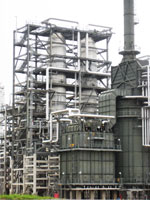The Refining Process
Petroleum products touch nearly every aspect of a person's life. Oil refining is simple in concept, complex to accomplish and fascinating to see it applied to daily life. This overview and the details that follow will provide a description of the units and processes used at Hunt Refining Company.
The central concept behind oil refining is distillation. Distillation separates crude oil into light (fuels) and (asphalt) heavy oils. In order to deliver finished products that meet quality standards, different light fuel streams are then sent through a series of product-specific treatments.
Click on the sections below for details about each process.
Crude Delivery and Storage
Crude oil is delivered to the refinery via barge, truck, railcar or pipeline and transferred to storage tanks. The crude oil is then sent to either the Delayed Coker Unit or the Crude Distillation Tower to begin the refining process.
Crude Distillation Unit
Distillation is the process by which various hydrocarbons are drawn off individually based on their varying boiling points inside of a distillation tower. The heaviest hydrocarbons have the highest boiling points and are pulled from the bottom of the tower, whereas lighter hydrocarbons are pulled from higher locations on the tower as the boiling points decrease.
The stream pulled from the very bottom of the distillation tower is known as reduced crude. This is further distilled in a vacuum distillation tower into asphalt and heavy gas oils. The light products from the distillation tower in order of boiling point from highest to lowest are: gas oil, diesel, kerosene and naphtha (gasoline).
Diesel, kerosene and naphtha all contain sulfur that must be removed to meet environmental regulations. Asphalt is further processed for sale into three grades: paving, roofing and industrial.
Delayed Coking Unit
The Delayed Coking Unit receives heavy crude oil as well as the heaviest hydrocarbon streams from the Crude Distillation Tower. This process thermally cracks heavy hydrocarbon streams to produce lighter components and solid petroleum coke.
The feed is run through a heater and sent to a distillation tower. The light hydrocarbons (naphtha, gas oils) are sent to a combination tower where they are further separated into various streams. The remaining (bottom) reduced crude is then heated and sent to coking drums.
The drums are kept at extremely high temperatures in order to thermally crack the reduced crude. This removes any remaining light hydrocarbons and leaves nearly pure carbon behind. This carbon product is called petroleum coke. When full, the coke drum is scraped clean of all coke, and the coke is sent to a containment area to be sold.
Hydrotreater (Sulfur Recovery)
Government regulations require petroleum products to limit the amount of sulfur they contain. Therefore, refineries must treat any stream containing sulfur.
This process is called hydrotreating. Hydrotreating extracts sulfur by passing the petroleum streams over fixed catalyst beds in the presence of excess hydrogen at elevated temperature and pressure. The removed sulfur combines with the excess hydrogen to form hydrogen sulfide.
The hydrogen sulfide is separated from the process stream and is sent to a sulfur recovery unit using the Claus sulfur recovery process. This technique partially combusts the hydrogen sulfide to form sulfur dioxide, and the remaining hydrogen sulfide then reacts with the newly formed sulfur dioxide to create water and elemental sulfur. This sulfur is sent to storage and is ready to be sold.
Hydrocracker
Hydrocracking is an essential technique in developing more efficient petroleum fuel products.
Hydrocracking is the process of taking long hydrocarbon chains and catalytically cracking
them into shorter chains. This is accomplished by passing the hydrocarbon stream over catalyst at a high pressure and temperature in an environment of excess hydrogen.
This process creates light, high-quality fuels by converting heavy gas oils and heavy naphtha into diesel and light naphtha, respectively. The diesel is a finished product that has ultra-low sulfur content and is sent to product storage for sale. The naphtha produced is further separated to remove butane and pentane, which are sent to gasoline blending. The remaining naphtha is fed to the Continuous Catalytic Regenerator Platformer for fractionation, isomerization and reforming.
CCR Platformer / Isomerization
The final step in refining gasoline is catalytic reforming and isomerization. The purpose of these processes is to enhance the fuel grade of the gasoline product.
This is accomplished by separating the naphtha feed into intermediate and heavy streams. The intermediate stream is fed to the isomerization unit for benzene saturation and octane upgrade. The heavy naphtha is catalytically reacted and separated into gasoline products. This process enhances the fuel grade by raising the octane number.
In order to have a constant catalytic reformation, a catalyst must be readily available. The Continuous Catalytic Regenerator Platformer achieves this through a complex, multistep process. The first step of this technique is to remove volatile hydrocarbons with heated hydrogen. The next step is to burn off carbon from the catalyst surface. The final step is restoring the surface area by routing the catalyst to a zone of high oxygen concentration within a chloride environment. The regenerated catalyst is then transferred back to the reaction stage of the process.






